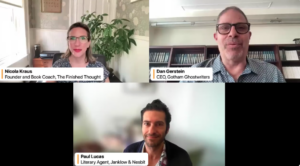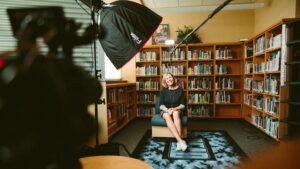Every so often, participants at the first-ever ‘Gathering of the Ghosts’ held at Manhattan’s historic New York Academy of Medicine could be forgiven if their attention wandered just a bit. Moderators and panelists held forth on subjects ranging from choosing the best publisher to promoting their work and brand to the all-important topic of money and what to charge – a sure crowd-pleaser. But all the while, behind the discussants, just in the back of the dais, a strange brass plaque caught the eye. Measuring three feet by three feet, it consisted of symmetrical rows of individual boxes labeled 1 to 49. Was it artwork? A geolocating identifier? Maybe even a strategically placed symbol of the Freemasons or some other secretive fraternal organization? No identifying tag or museum label was anywhere nearby to give any indication of what it could be.
“Oh, that? It’s the readers call board,” explains the Academy’s Historical Collections Librarian, Arlene Shaner. “Each of the individual numbers has a switch that lights it up.”
The antique device suggests why the Academy’s historic headquarters at 5th Avenue and 103rd, just across from Central Park, was such an ideal gathering spot for a crowd of those who write, read, and cherish the book. Though the Academy – known widely by its initials, NYAM – was founded in 1847 as a private, member-only informational resource for New York’s medical community, by 1878, its managing council decided to open its then-6,000 book collection to the general public. To this day, the library is New York City’s only medical library open to any interested researcher, and it is one of the few in the nation with this policy.
Today, NYAM’s medical collection is one of the foremost in the world, with about 550,000 volumes in the building, as well as archives, manuscripts, artifacts, and hundreds of thousands of pamphlets and other ephemera. In the collection are about 32,000 truly rare books, dating all the way back to the Edwin Smith Surgical Papyrus, an ancient Egyptian manuscript from around 1700 BCE containing 48 case histories describing treatments for wounds of the head and torso, a collection of spells and remedies, and the world’s first use of written symbols for the word brain.
The Academy’s headquarters building opened almost a century ago, in 1926. As a closed-stacks, non-circulating library, the general public could come in to access any book or publication but could not take them home.
Until about 2008, the room where the Gathering of the Ghosts took place was the library’s general reading room. “There was a whole team of pages who spent the day retrieving books and journals, photocopying articles for people, and reshelving things, and the room was usually very busy,” recalls Shaner, who has been with the Library for 23 years. “In addition to researchers, lots of medical students would come over to study in the reading rooms.”
The main reading room at that time was filled with stately custom-made tables surrounded by a dozen or so chairs. And each of those chairs had a specific number. Patrons would use the card catalogs to locate the material they wanted and write the call numbers on a slip of paper given to the pages to retrieve the requested item. When the page delivered the material, the reading room librarian would flip a switch that would light up the chair number associated with the request on the big brass readers call board, and patrons would claim their request.
“All of this changed dramatically as we made the shift to electronic journals and then electronic textbooks,” says Shaner. “As electronic journals became more available to people at their own libraries, they came to our library in person less and less until we finally made the decision to repurpose that big reading room as an event space.” Today, patrons visiting the library to access materials in person do so in the much smaller rare books reading room located on another floor of the building.
None of which diminishes NYAM’s central role in providing free and unfettered access to medical information to the general public. Says Shaner, “We don’t teach anyone how to be a doctor here – we’re a fellowship organization for healthcare and public health professionals and a policy organization whose mission has for quite some time now focused in one way or another on addressing issues related to health equity.”
Indeed, across a 177-year history, NYAM remains a leading voice for innovation in public health, sponsoring research, programs, and policy initiatives that combat health inequities across all communities. And it all started with an idea to collect and share books. “How we express that has changed over time, but it’s been part of the organization’s concerns in one way or another for a long time.”



